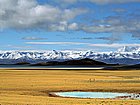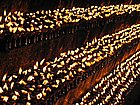西藏手冊(82):拉薩(3)-大昭寺之二
西藏手冊(82):拉薩(3)-大昭寺之二
Inner Jokhang
-------------
======= Ground Floor =========
Main Gate (Zhung-go): embedded in the flagstones in front of the gate
is a fossil known as Amolongkha, and a footprint of Dalai Lama XIII.
The gate is ornamented with Derge crafted metal-work and surrouned
by murals depicting Maitreya (left), Je Yabsesum (above), and
Dipamkara (right).
------ Entrance Hall ---------
The outermost rooms of the portico including the Driza Zurphu Ngapa
are empty, while the innermost chambers depict the wrathful pretector
deities: yaksas (Nojinkhang), Shridevi and Mahakala on the N side;
and benign naga kings (Lukhang) as well as the Othang Lake seal on
the S side. These protectors are said to have appeared to Songtsen
Gampo in a vision during the original construction of the Jokhang,
and were charged with its protection.
Kyilkhor Thil (Inner Hall)
The 2-storey inner hall is divided into three sections - two with
short columns (kawa thungthung) and one with long columns
(kawa ringbo). Immediately beyond the entrance, there are two rows
of short columns running N-S, the southernmost ones bearing tangkas
of the Sixteen Elders. Then, in the centre of the hall, are six large
statues: a 6m west-facing image of Padmasambhava (erected by
Khyentse Rinpoche and consecrated by Minling Chung Rinpoche),
a 4m N-facing image of Barzhi Jampa (commissioned by the Barzhi
family), a 10m west-facing image of Thuwang Zangthama, a 8m N-facing
image of Miwang Jampa (cast in 1736, its auras and jewels have been
replaced), and at their centre a 4m Mahakarunika with a small
Padmasambhava to its rear. The tallest columns (9 in 4 groups) which
support the skylight are painted and date from the period of Gade
Zangpo's restoration.
An inner row of 12 short columns (kawa thung-thung) with six to each
side of the Jowo Lhakhang, running S-N in front of the inner sanctum,
probably dates from the 7th century. These are characterized by short
bases and round shafts, suggesting an authentic Nepalese design.
Five of them (three at the N end and two at the S end) were plastered
probably in the 14th century for protection or reinforcement - by
Gade Zangpo and his son. A cornice comprising 144 lion-faced figures
also dates from the earliest phase, as do some of the interior
door-frames.
Within the hall, there are various chapels which the pilgrim will
pass through in a clockwise manner, as follows:
---------- West Wing ------------
Je Rinpoche Dakpa Namgye Lhakhang
This chapel contains a central image of Tsongkhapa, surrounded by
his eight pure retainers, including Khedrubje and Gyeltsabje, who
accompanied the master on his meditative retreats at Chokhorgyel and
elsewhere. Outside the entrance, a monk inscribes with gold ink on
red paper the names of deceased persons or petitioners, which are
then burned as offerings.
Amitabha Lhakhang
Outside this chapel is the Tagpa Chorten, a stupa originally
fashioned by Sakya Pandita in the 13th century, and containing
certain relics of King Songtsen Gampo.
---------- North Wing ----------
Menlha Desheg Gye Lhakhang: this chapel is dedicated to the Eight
Medicine Buddhas. Outside is an earthen platform with an image of
Milarepa.
Mahakarunika Lhakhang
Within the chain metal curtain of this chapel, the door of which
appears to have an original frame, there is a restored image of the
deity Mahakarunika. The original image, known as Thuje Chenpo
Rangjung Ngaden, is said to have been imbued with the life-force of
five beings (ngaden), namely: King Songtsen Gampo, his two foreign
queens, and the gatekeeping deities Amritakundalin and Hayagriva.
It also contained buddha relics from Bodh Gaya in India which had
been brought to Tibet by Lodro Jungne an emanation of King
Songtsen Gampo. That original image was severely damaged during the
Cultural Revolution, and part of it smuggled to Dharamsala. One
portion, however, is contained within the new replica. The image is
one of the four in the Jokang with a gilded roof. The chapel also
contains secondary images of: Khasarpani, Tara, Marici, Hayagriva,
Lokeshvara, Bhrikuti, Prajnaparamita, and Amritakundalin.
Jampa Truze Lhakhang
The principal image is a seated Maitreya with an impressive aureole,
and fronted by an old restored image of Manjughosa. On its left are
images of Amitabha, White Tara, Vajrapani, Avalokiteshvara and
Manjughosa. On its right is Tsongkhapa flanked by the reliquaries of
Ngaripa Tsondu Nyingpo (who sculpted the chapels' original images)
and Ngok Lekpei Sherab. In the centre of the chapel is a stone butter
bowl, made by Tsongkhapa. Over the door is a replica of an original
Mani Stone engraving (which was one of the Jokhang's most precious
artefacts). The stone platform outside the door was once used by
King Songtsen Gampo and his queens while bathing, and it is said that
the actual clay of the Maitreya image within was mixed with bath
water prior to its construction.
Othang Gyatso Lhakhang
This chapel contains a stone slab, which is said to give access to a
subterranean lake below the Jokhang's foundation. Annual offerings
were formerly made in this chapel by the Tibetan Government. Now it
is mostly blocked-off by the Tsongkhapa Lhakhang.
Tsongkhapa Lhakhang
A covered elevated platform supports a small image of Tsongkhapa
called Nangyen Ngadrama, which is flanked on the left by
Sakya Choje Kunga Tashi and Buton Rinchendrub, and on the right by
Asanga, Sonam Gyeltsen, Dorje Gyeltsen, and Karmpa III. The origianl
central image is said to have been made in Tsongkhapa's lifetime,
but there are other traditions attributing its miraculous
construction to the protector deity Dharmaraja, or alternatively to
a later Mongol emperor.
--------- East Wing -------------
Amitabha Lhakhang (Room where final obstacles are dispelled)
The entrance to this chapel is guarded by Vajrapani and
Ucchusmakrodha - the former could not be budged by Lhangdarma's
henchemen, and the latter reputedly repelled a Chinese invasion
following the death of Songtsen. Note the original sloping Newar
door-frame with its unpainted patina. Inside is an image of Amitabha
flanked on the left by Vajrapani and on the right by Hayagriva,
while the Eight Bodhisattvas are on the side-walls. Outside the
chamber to the S is a stone platform with images of Sontsen Gampo,
his two foreign queens, and Guru Saroruhavajra (commissioned by
Dalai Lama XIII). The platform originally supported images of the
Four Guardian Kings, as sculpted by tripa Monalm Dorje, using clay
from Samye. The fourth 'light-emanating' image of the Jokhang,
Dolma Darlenma, was also once positioned in this chapel. The statue
had received its name after reputedly requesting Sakya Pandita for
an offering scarf.
Jowo Lhakhang Foyer
The highly polished wooden floor of the foyer is flanked by two pairs
of guardian kings (with wrathful demeanour on the S side and smiling
demeanour on the N side). The original guardians, now destroyed,
were attributed either to Princess Wengcheng or Princess Jincheng.
the elaborately decorated high ceilings display a marked Newar
influence. An image of Padmasambhava, sculpted in the 18th century
by Orgyan Drodul Lingpa, admonishes the naga spirits to stay away.
Jowo Shakyamuni Lhakhang
The inner sanctum, which is the largest and loftiest chapel of the
Jokhang and one of four with a gilded roof, contains Tibet's most
revered image - the 1.5m image of Jowo Rinpoche, representing the
Buddha at the age of 12. This image was reputedly made of an alloy
of precious metals mixed with jewels by Visvakarman in Kapalavastu,
and in later times presented to China by the king of Magadha to
commemeorate the defeat of the Yavanas. Subsequently it was brought
to Tibet by Princess Wengcheng. One tradition recorded by Tucci
states that the original was partially destroyed in 1717 by the
Dzungars, the present image being stylistically later. Originally
housed in the Ramoche temple, it was later brought to the Jokhang
by Wengcheng on the death of Songtsen Gampo and interred in a chamber
on the S side behind a painting of Manjughosa. Queen Jincheng
subsequently recovered it and installed it as the central image of
the Jokhang. Later it was buried in sand after Trisong's disloyal
Bon ministers chose to return it to China and 300 men could not move
it. During that period, the temple was converted to a slaughterhouse.
Subsequently the image was once again buried in sand by Langdarma who
had the gates of the Jokhang plastered with the picture of a monk
drinking wine. The head-dress and ear-ornaments (na-gyen) originally
date from time of Tsongkhapa (but have been replaced in recent times),
and the pearl-studded robe from that of the Da Ming emperor. The image
was conserved without damage during the Cultural Revolution, during
which period the temple was utilized as a military barracks and its
outer courtyard as a slaughthouse.
Entering the inner sancutm, the pilgrim finds the main image seated
upon a three-tiered stone platform; flanked by smaller images of
Maitreya and Manjughosa. There are ornate silver-plated pillars with
dragon motifs supporting an overhead canopy; and a silver sphere
above the crown, which was donated by a Mongol Qan. Side-steps at the
S and N sides grant access to the pilgrim, who can then make offerings
directly to the image. Behind the Jowo Rinpoche image, there is a
copper plaque with an inscription commemorating Anige's 13th century
restoration of the throne back and the aureole. In front of the plaque
is an E-facing image of Dipamkara Buddha called Acala, which stands
back-to-back with Jowo Rinpoche, and is claimed to have onc been the
central image. Facing the latter, at the back of the chapel is a 6m
image of Thubpa Gangchentso, flanked by the Twelve Bodhisattvas,
along with the gatekeepers Vajrapani and Hayagriva - all of which
were sculpted by Zangkar Lotsawa. Other statues of the inner sanctum
depict Dalai Lama VII, Dalai Lama XIII and Tsongkhapa.
Outside the chapel to the S is a raised platform with images of Atisha
flanked by Dromtonpa and Ngok Lekpei Sherab. Behind Dromtonpa is a
mural depicting a 'speaking' form of Tara (Dolma Sungjonma).
Jestun Jampa Gonpo Lhakhang
This chapelwhich has an original 7th century Newar door-frame,
contains as its main image Jampa Chokhor. This image is held to have
been an emanation of King Krikin, which was brought to Tibet from
Nepal as part of Princess Bhrikuti's dowry. The present statue is a
replica but the finely carved aureole may be original. Flanking the
main image are the Eight Taras Who Protect from Fear; with
Avalokiteshvara in the form Chenrezi Semnyi Ngalso in front, and a
replica of Princess Wengcheng's stove in the NW corner. The original
Maitreya image formerly was the centrepiece of the second storey.
Outside on a platform are image of Amitayus, Dolpopa Sherab Gyeltsen,
and Four-armed Avalokiteshvara.
Chenrezi Sengedradrok Lhakhang
The main image here is of Amitabha, flanked by six emanations of
Avalokiteshvara, of which the first left gives the chapel its name.
Outside is a 1.5m stone column with a hole at the top, to which
pilgrims press their ears in order to hear the sound of the mythical
anga bird at the bottom of Othang Lake.
--------- South Wing ---------
Yungdrung Phuk
In the SE corner beyond the stairs are two images of Padmasambhava
and one of King Trisong Detsen, along with a painting of the Medicine
Buddha, which is said to have been fashioned out of light rays
emanating from Avalokiteshvara's heart.
Janzik Lhakhang (closed)
Outside are new murals depicting Songtsen Gampo and his two foreign
queens with the ministers Gar and Tonmi. The original paintings had
been commissioned by Monlam Dorje of Tsel Gungtang.
Jampa Chezhi Lhakang
This chapel, which is one of the four with a gilded roof, contains an
image of Maitreya, which was brought from Drepung to replace the
(now destroyed) silver Maitreya, which was traditionally escorted
around the Barkhor on the 25th day of the first lunar month during
the Jampa Dendren ceremony. Other statues contained within this
chapel include: Manjughosa, Khasarpani, Mahakarunika, Vajrasattava,
and Jambhala, as well as Lharje Gewabum, who is said to have built
one of the Kyichu dykes. Behind the image of the protector Gek Tarje
at the NE corner of the chape, and alongside a Padmasambhava image,
is a 0.5m gilded goat's head, replacing a reputedly self-arising
original. This depicts the legendary Queen of Goats (Dungtse Ra'si
Gyelmo) who presided over the filling-in of the Othang Lake.
Menlha Deshek Gye'i Lhakhang (Jowo Besai Lhakhang)
This is the chapel in which the Jowo Rinpoche image was hidden by
Princess Wengcheng within a cavity behind the buddha-image of the
E wall. The main images depict Amitabha and the Eight Medicine
Buddhas. The image of Manjughosa, known as Jampeyang Koyolma, which
is depicted on the outer wall, is said to have spoken to Princess
Jincheng, agreeing to move aside so that the staute could be
extracted. West of the entrance are images of the Five Founders
(Gongma Nga) of Sakya.
Sangye Rabdun Lhakhang
This chapel depicts the Seven Generations of Past Buddhas, one of
which supposedly flew there from India.
Tsepak Lhagu Lhakhang
This chapel depicts the Nine Aspects of Amitayus, deity of longevity.
Outside on the SW wall is a mural depicting Prajnaparamita, with a
reputedly self-arising eye, which appeared when an old lady
miraculously had her sight restored on praying to the image. Other
murals in this alcove depict the Three Deities of Longevity
(Tselha Namsum).
-------- West Wing ----------
Chogyel Tonmi Lhakhang
In this royal chapel, King Songtsen Gampo is flanked (on the left) by:
Gar, Bhrikuti, Nyatri Tsenpo, and Trisong Detsen; and (on the right)
by: Relpachen, Lhatotori, Wengcheng, and Tonmi Sambhota. Formerly it
also contained images of Mongza Tricham, Gungru Gungtsen, and Zhang
Lonnyi. The room has original offering bowls and lamps. Outside are
important murals depicting the foundation of the Jokhang and the
events of Songtsen Gampo's reign, including the construction of the
first Potala Palace.
TIBET HANDBOOK
Gyurme Dorje
Trade & Travel Publications Ltd. January 1996
ISBN 0 900571 69 X
Inner Jokhang
-------------
======= Ground Floor =========
Main Gate (Zhung-go): embedded in the flagstones in front of the gate
is a fossil known as Amolongkha, and a footprint of Dalai Lama XIII.
The gate is ornamented with Derge crafted metal-work and surrouned
by murals depicting Maitreya (left), Je Yabsesum (above), and
Dipamkara (right).
------ Entrance Hall ---------
The outermost rooms of the portico including the Driza Zurphu Ngapa
are empty, while the innermost chambers depict the wrathful pretector
deities: yaksas (Nojinkhang), Shridevi and Mahakala on the N side;
and benign naga kings (Lukhang) as well as the Othang Lake seal on
the S side. These protectors are said to have appeared to Songtsen
Gampo in a vision during the original construction of the Jokhang,
and were charged with its protection.
Kyilkhor Thil (Inner Hall)
The 2-storey inner hall is divided into three sections - two with
short columns (kawa thungthung) and one with long columns
(kawa ringbo). Immediately beyond the entrance, there are two rows
of short columns running N-S, the southernmost ones bearing tangkas
of the Sixteen Elders. Then, in the centre of the hall, are six large
statues: a 6m west-facing image of Padmasambhava (erected by
Khyentse Rinpoche and consecrated by Minling Chung Rinpoche),
a 4m N-facing image of Barzhi Jampa (commissioned by the Barzhi
family), a 10m west-facing image of Thuwang Zangthama, a 8m N-facing
image of Miwang Jampa (cast in 1736, its auras and jewels have been
replaced), and at their centre a 4m Mahakarunika with a small
Padmasambhava to its rear. The tallest columns (9 in 4 groups) which
support the skylight are painted and date from the period of Gade
Zangpo's restoration.
An inner row of 12 short columns (kawa thung-thung) with six to each
side of the Jowo Lhakhang, running S-N in front of the inner sanctum,
probably dates from the 7th century. These are characterized by short
bases and round shafts, suggesting an authentic Nepalese design.
Five of them (three at the N end and two at the S end) were plastered
probably in the 14th century for protection or reinforcement - by
Gade Zangpo and his son. A cornice comprising 144 lion-faced figures
also dates from the earliest phase, as do some of the interior
door-frames.
Within the hall, there are various chapels which the pilgrim will
pass through in a clockwise manner, as follows:
---------- West Wing ------------
Je Rinpoche Dakpa Namgye Lhakhang
This chapel contains a central image of Tsongkhapa, surrounded by
his eight pure retainers, including Khedrubje and Gyeltsabje, who
accompanied the master on his meditative retreats at Chokhorgyel and
elsewhere. Outside the entrance, a monk inscribes with gold ink on
red paper the names of deceased persons or petitioners, which are
then burned as offerings.
Amitabha Lhakhang
Outside this chapel is the Tagpa Chorten, a stupa originally
fashioned by Sakya Pandita in the 13th century, and containing
certain relics of King Songtsen Gampo.
---------- North Wing ----------
Menlha Desheg Gye Lhakhang: this chapel is dedicated to the Eight
Medicine Buddhas. Outside is an earthen platform with an image of
Milarepa.
Mahakarunika Lhakhang
Within the chain metal curtain of this chapel, the door of which
appears to have an original frame, there is a restored image of the
deity Mahakarunika. The original image, known as Thuje Chenpo
Rangjung Ngaden, is said to have been imbued with the life-force of
five beings (ngaden), namely: King Songtsen Gampo, his two foreign
queens, and the gatekeeping deities Amritakundalin and Hayagriva.
It also contained buddha relics from Bodh Gaya in India which had
been brought to Tibet by Lodro Jungne an emanation of King
Songtsen Gampo. That original image was severely damaged during the
Cultural Revolution, and part of it smuggled to Dharamsala. One
portion, however, is contained within the new replica. The image is
one of the four in the Jokang with a gilded roof. The chapel also
contains secondary images of: Khasarpani, Tara, Marici, Hayagriva,
Lokeshvara, Bhrikuti, Prajnaparamita, and Amritakundalin.
Jampa Truze Lhakhang
The principal image is a seated Maitreya with an impressive aureole,
and fronted by an old restored image of Manjughosa. On its left are
images of Amitabha, White Tara, Vajrapani, Avalokiteshvara and
Manjughosa. On its right is Tsongkhapa flanked by the reliquaries of
Ngaripa Tsondu Nyingpo (who sculpted the chapels' original images)
and Ngok Lekpei Sherab. In the centre of the chapel is a stone butter
bowl, made by Tsongkhapa. Over the door is a replica of an original
Mani Stone engraving (which was one of the Jokhang's most precious
artefacts). The stone platform outside the door was once used by
King Songtsen Gampo and his queens while bathing, and it is said that
the actual clay of the Maitreya image within was mixed with bath
water prior to its construction.
Othang Gyatso Lhakhang
This chapel contains a stone slab, which is said to give access to a
subterranean lake below the Jokhang's foundation. Annual offerings
were formerly made in this chapel by the Tibetan Government. Now it
is mostly blocked-off by the Tsongkhapa Lhakhang.
Tsongkhapa Lhakhang
A covered elevated platform supports a small image of Tsongkhapa
called Nangyen Ngadrama, which is flanked on the left by
Sakya Choje Kunga Tashi and Buton Rinchendrub, and on the right by
Asanga, Sonam Gyeltsen, Dorje Gyeltsen, and Karmpa III. The origianl
central image is said to have been made in Tsongkhapa's lifetime,
but there are other traditions attributing its miraculous
construction to the protector deity Dharmaraja, or alternatively to
a later Mongol emperor.
--------- East Wing -------------
Amitabha Lhakhang (Room where final obstacles are dispelled)
The entrance to this chapel is guarded by Vajrapani and
Ucchusmakrodha - the former could not be budged by Lhangdarma's
henchemen, and the latter reputedly repelled a Chinese invasion
following the death of Songtsen. Note the original sloping Newar
door-frame with its unpainted patina. Inside is an image of Amitabha
flanked on the left by Vajrapani and on the right by Hayagriva,
while the Eight Bodhisattvas are on the side-walls. Outside the
chamber to the S is a stone platform with images of Sontsen Gampo,
his two foreign queens, and Guru Saroruhavajra (commissioned by
Dalai Lama XIII). The platform originally supported images of the
Four Guardian Kings, as sculpted by tripa Monalm Dorje, using clay
from Samye. The fourth 'light-emanating' image of the Jokhang,
Dolma Darlenma, was also once positioned in this chapel. The statue
had received its name after reputedly requesting Sakya Pandita for
an offering scarf.
Jowo Lhakhang Foyer
The highly polished wooden floor of the foyer is flanked by two pairs
of guardian kings (with wrathful demeanour on the S side and smiling
demeanour on the N side). The original guardians, now destroyed,
were attributed either to Princess Wengcheng or Princess Jincheng.
the elaborately decorated high ceilings display a marked Newar
influence. An image of Padmasambhava, sculpted in the 18th century
by Orgyan Drodul Lingpa, admonishes the naga spirits to stay away.
Jowo Shakyamuni Lhakhang
The inner sanctum, which is the largest and loftiest chapel of the
Jokhang and one of four with a gilded roof, contains Tibet's most
revered image - the 1.5m image of Jowo Rinpoche, representing the
Buddha at the age of 12. This image was reputedly made of an alloy
of precious metals mixed with jewels by Visvakarman in Kapalavastu,
and in later times presented to China by the king of Magadha to
commemeorate the defeat of the Yavanas. Subsequently it was brought
to Tibet by Princess Wengcheng. One tradition recorded by Tucci
states that the original was partially destroyed in 1717 by the
Dzungars, the present image being stylistically later. Originally
housed in the Ramoche temple, it was later brought to the Jokhang
by Wengcheng on the death of Songtsen Gampo and interred in a chamber
on the S side behind a painting of Manjughosa. Queen Jincheng
subsequently recovered it and installed it as the central image of
the Jokhang. Later it was buried in sand after Trisong's disloyal
Bon ministers chose to return it to China and 300 men could not move
it. During that period, the temple was converted to a slaughterhouse.
Subsequently the image was once again buried in sand by Langdarma who
had the gates of the Jokhang plastered with the picture of a monk
drinking wine. The head-dress and ear-ornaments (na-gyen) originally
date from time of Tsongkhapa (but have been replaced in recent times),
and the pearl-studded robe from that of the Da Ming emperor. The image
was conserved without damage during the Cultural Revolution, during
which period the temple was utilized as a military barracks and its
outer courtyard as a slaughthouse.
Entering the inner sancutm, the pilgrim finds the main image seated
upon a three-tiered stone platform; flanked by smaller images of
Maitreya and Manjughosa. There are ornate silver-plated pillars with
dragon motifs supporting an overhead canopy; and a silver sphere
above the crown, which was donated by a Mongol Qan. Side-steps at the
S and N sides grant access to the pilgrim, who can then make offerings
directly to the image. Behind the Jowo Rinpoche image, there is a
copper plaque with an inscription commemorating Anige's 13th century
restoration of the throne back and the aureole. In front of the plaque
is an E-facing image of Dipamkara Buddha called Acala, which stands
back-to-back with Jowo Rinpoche, and is claimed to have onc been the
central image. Facing the latter, at the back of the chapel is a 6m
image of Thubpa Gangchentso, flanked by the Twelve Bodhisattvas,
along with the gatekeepers Vajrapani and Hayagriva - all of which
were sculpted by Zangkar Lotsawa. Other statues of the inner sanctum
depict Dalai Lama VII, Dalai Lama XIII and Tsongkhapa.
Outside the chapel to the S is a raised platform with images of Atisha
flanked by Dromtonpa and Ngok Lekpei Sherab. Behind Dromtonpa is a
mural depicting a 'speaking' form of Tara (Dolma Sungjonma).
Jestun Jampa Gonpo Lhakhang
This chapelwhich has an original 7th century Newar door-frame,
contains as its main image Jampa Chokhor. This image is held to have
been an emanation of King Krikin, which was brought to Tibet from
Nepal as part of Princess Bhrikuti's dowry. The present statue is a
replica but the finely carved aureole may be original. Flanking the
main image are the Eight Taras Who Protect from Fear; with
Avalokiteshvara in the form Chenrezi Semnyi Ngalso in front, and a
replica of Princess Wengcheng's stove in the NW corner. The original
Maitreya image formerly was the centrepiece of the second storey.
Outside on a platform are image of Amitayus, Dolpopa Sherab Gyeltsen,
and Four-armed Avalokiteshvara.
Chenrezi Sengedradrok Lhakhang
The main image here is of Amitabha, flanked by six emanations of
Avalokiteshvara, of which the first left gives the chapel its name.
Outside is a 1.5m stone column with a hole at the top, to which
pilgrims press their ears in order to hear the sound of the mythical
anga bird at the bottom of Othang Lake.
--------- South Wing ---------
Yungdrung Phuk
In the SE corner beyond the stairs are two images of Padmasambhava
and one of King Trisong Detsen, along with a painting of the Medicine
Buddha, which is said to have been fashioned out of light rays
emanating from Avalokiteshvara's heart.
Janzik Lhakhang (closed)
Outside are new murals depicting Songtsen Gampo and his two foreign
queens with the ministers Gar and Tonmi. The original paintings had
been commissioned by Monlam Dorje of Tsel Gungtang.
Jampa Chezhi Lhakang
This chapel, which is one of the four with a gilded roof, contains an
image of Maitreya, which was brought from Drepung to replace the
(now destroyed) silver Maitreya, which was traditionally escorted
around the Barkhor on the 25th day of the first lunar month during
the Jampa Dendren ceremony. Other statues contained within this
chapel include: Manjughosa, Khasarpani, Mahakarunika, Vajrasattava,
and Jambhala, as well as Lharje Gewabum, who is said to have built
one of the Kyichu dykes. Behind the image of the protector Gek Tarje
at the NE corner of the chape, and alongside a Padmasambhava image,
is a 0.5m gilded goat's head, replacing a reputedly self-arising
original. This depicts the legendary Queen of Goats (Dungtse Ra'si
Gyelmo) who presided over the filling-in of the Othang Lake.
Menlha Deshek Gye'i Lhakhang (Jowo Besai Lhakhang)
This is the chapel in which the Jowo Rinpoche image was hidden by
Princess Wengcheng within a cavity behind the buddha-image of the
E wall. The main images depict Amitabha and the Eight Medicine
Buddhas. The image of Manjughosa, known as Jampeyang Koyolma, which
is depicted on the outer wall, is said to have spoken to Princess
Jincheng, agreeing to move aside so that the staute could be
extracted. West of the entrance are images of the Five Founders
(Gongma Nga) of Sakya.
Sangye Rabdun Lhakhang
This chapel depicts the Seven Generations of Past Buddhas, one of
which supposedly flew there from India.
Tsepak Lhagu Lhakhang
This chapel depicts the Nine Aspects of Amitayus, deity of longevity.
Outside on the SW wall is a mural depicting Prajnaparamita, with a
reputedly self-arising eye, which appeared when an old lady
miraculously had her sight restored on praying to the image. Other
murals in this alcove depict the Three Deities of Longevity
(Tselha Namsum).
-------- West Wing ----------
Chogyel Tonmi Lhakhang
In this royal chapel, King Songtsen Gampo is flanked (on the left) by:
Gar, Bhrikuti, Nyatri Tsenpo, and Trisong Detsen; and (on the right)
by: Relpachen, Lhatotori, Wengcheng, and Tonmi Sambhota. Formerly it
also contained images of Mongza Tricham, Gungru Gungtsen, and Zhang
Lonnyi. The room has original offering bowls and lamps. Outside are
important murals depicting the foundation of the Jokhang and the
events of Songtsen Gampo's reign, including the construction of the
first Potala Palace.
TIBET HANDBOOK
Gyurme Dorje
Trade & Travel Publications Ltd. January 1996
ISBN 0 900571 69 X
 MITS 美景國際旅行社
MITS 美景國際旅行社MEIJING INTERNATIONAL TRAVEL SERVICE LTD
專門為台灣/香港/澳門等世界各地華人、外國人(外籍遊客)提供特色西藏、青海、
尼泊爾、四川等地度假觀光旅行服務,為您量身定制個性旅行計劃(獨立成團、小
包團、自由行、團體旅遊、散客拼團,另提供各類朝聖、徒步登山探險等特種旅遊)
外籍遊客進藏旅行須知:辦理台灣遊客入藏批准函.旅行證件.外國人去西藏旅行手續
Sponsored Links
特別聲明:
A:關於美景旅遊網獨立原創文章圖片等內容
1、美景旅遊網原創文章、圖片版權由我們全部保留;
2、美景旅遊網原創文章、圖片任何網站及媒體均可以免費使用,如轉載我們的文章或圖片,
請註明來自美景旅遊網 並鏈接到 www.mjjq.com,商業用途請先聯繫我們;
3、免責:我們在我們能知悉的範圍內努力保證所有采寫文章的真實性和正確性,但不對真實性和正確性做任何保證。本站采寫文章圖片如果和事實有所出入,美景旅遊網不承擔連帶責任;
B:關於美景旅遊網採用非原創文章圖片等內容
1、頁面的文章、圖片等等資料的版權歸版權所有人所有。
2、免責:由於採集的圖片、文章內容來源於互聯網,內容頁面標注的作者、出處和原版權者一致性無法確認,如果您是文章、圖片等資料的版權所有人,請與我們聯繫,我們會及時加上版權信息,如果您反對我們的使用,本著對版權人尊重的原則,我們會立即刪除有版權問題的文章或圖片內容。
3、本頁面發表、轉載的文章及圖片僅代表作者本人觀點。
A:關於美景旅遊網獨立原創文章圖片等內容
1、美景旅遊網原創文章、圖片版權由我們全部保留;
2、美景旅遊網原創文章、圖片任何網站及媒體均可以免費使用,如轉載我們的文章或圖片,
請註明來自美景旅遊網 並鏈接到 www.mjjq.com,商業用途請先聯繫我們;
3、免責:我們在我們能知悉的範圍內努力保證所有采寫文章的真實性和正確性,但不對真實性和正確性做任何保證。本站采寫文章圖片如果和事實有所出入,美景旅遊網不承擔連帶責任;
B:關於美景旅遊網採用非原創文章圖片等內容
1、頁面的文章、圖片等等資料的版權歸版權所有人所有。
2、免責:由於採集的圖片、文章內容來源於互聯網,內容頁面標注的作者、出處和原版權者一致性無法確認,如果您是文章、圖片等資料的版權所有人,請與我們聯繫,我們會及時加上版權信息,如果您反對我們的使用,本著對版權人尊重的原則,我們會立即刪除有版權問題的文章或圖片內容。
3、本頁面發表、轉載的文章及圖片僅代表作者本人觀點。
西藏旅遊
Tibet Travel
西藏旅遊目的地 
走進神秘西藏
西藏風光圖庫
熱門點擊 
最新旅遊報價










